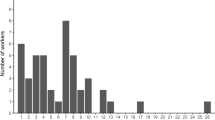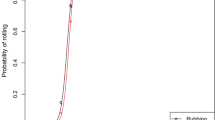Abstract
Carpenter ants were found to escape from and avoid prolonged exposures to 20–80 R/sec. x-rays when tested in the fall. Using ionizing radiation as the unconditioned stimulus, it was possible to establish a strong conditioned avoidance response toward the place of exposure (1 compartment of a 2-compartment, free-choice chamber). This compartment was initially preferred by the experimental Ss. Exposures under identical conditions in the spring resulted in the movement of ants into, rather than away from, the radiation field. It was not possible in the spring to condition either a positive or a negative response toward the place of exposure. Carpenter ants may undergo significant changes in physiological state at different times of the year which affect their behavior toward ionizing radiations.
Similar content being viewed by others
References
BROWER, J. H. 1966. Behavioral changes in an ant colony exposed to chronic gamma irradiation The American Midland Naturalist, 75, 530–534.
HOELLDOBLER, B. 1961. Temperaturunabhaengige rhythmische Erscheinungen bei Rossameisenkolonien (Campanotus ligniperda Latr. und Camponotus herculeanus L.). Insectes Sociaux, 8, 13–22.
HUG, O. 1960. Reflex-like responses of lower animals and mammalian organs to ionizing radiation International Journal of Radiation Biology Supplement, 2, 217–226.
KIMELDORF, D. J., DEDRICK, M. C., FORTNER, R. W., & MARTINSEN, D. L. 1971. The mortality response of three invertebrate species to single x-ray exposures Radiation Research, 47, 300.
KIMELDORF, D. J., & HUNT, E. L. 1965. Ionizing radiation: Neural function and behavior. New York: Academic Press.
KREBS, A., & BENSON, B. 1966. Effects of cobalt-60 gamma radiation on the natural digging and tunneling behavior of the ant Pogonomyrmex californicus. Naturwissenschaften, 53, 131.
SMITH, J. C. 1971. Radiation, its detection and its effects on taste preferences. In E. Steller & J. M. Sprague (Eds.), Progress in psysiological psychology, Vol. 4. New York: Academic Press. Pp. 53–118.
WEIR, J. 1958. Polyethism in workers of the ant Myrmica. Insectes Sociaux, 5, 97–128.
WILSON, E. O. 1963. The social biology of ants Annual Review of Entomology, 8, 345–368.
Author information
Authors and Affiliations
Additional information
This investigation was supported by USPHS. Food and Drug Administration, Bureau of Radiological Health, under Research Grant RL00119 and by a traineeship in environmental toxicology, USPHS Grant ES00055, to D. L. Martinsen.
Rights and permissions
About this article
Cite this article
Martinsen, D.L., Kimeldorf, D.J. Conditioned Spatial Avoidance Behavior of Ants Induced By X-Rays. Psychol Rec 22, 225–232 (1972). https://doi.org/10.1007/BF03394084
Published:
Issue Date:
DOI: https://doi.org/10.1007/BF03394084




